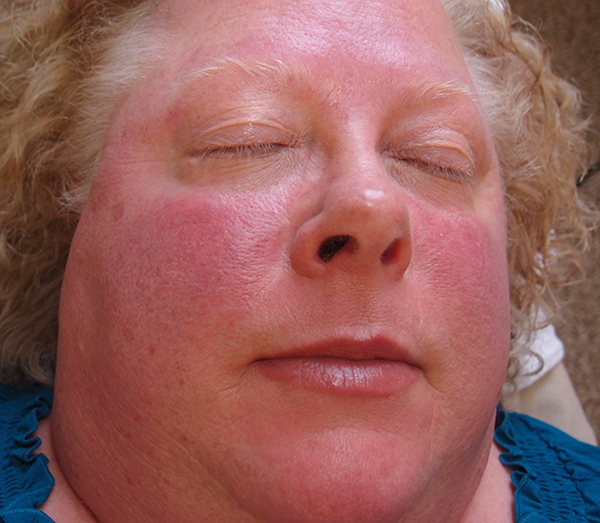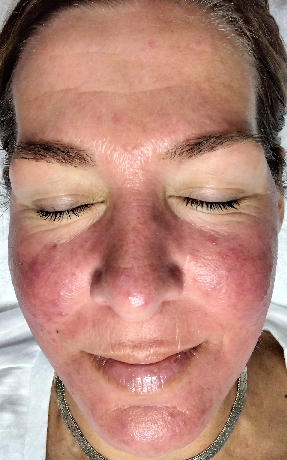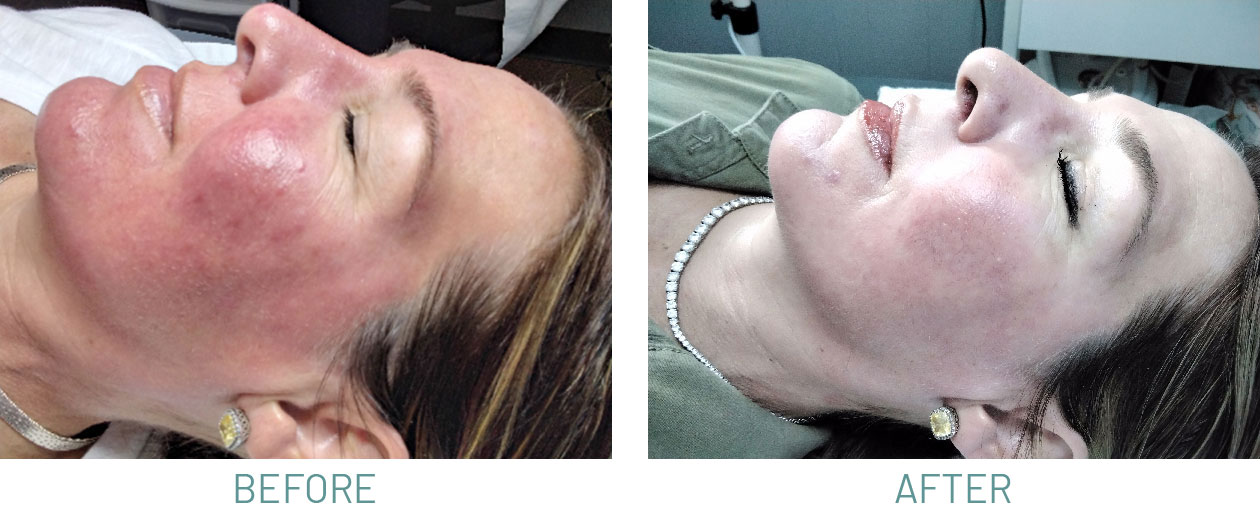
Looking For Rosacea Treatment
In The Denver Area?
Are you looking for a real solution to your rosacea and not just a cream from the derm?
If so, you are in the right place. Our Rosacea Clearing Program will repair your skin and eliminate superficial redness in 12-weeks.
If you’ve struggled with flushing, acne, and other symptoms, it’s likely you have rosacea (also known as acne rosacea). This condition commonly affects people over age 30, with redness and flushing over the forehead, cheeks, or chin.
Acne rosacea is a chronic condition with symptoms that come in cycles -- worsening, then waning, then subsiding.
Before & After Photos
Who Is At Highest Risk?
Fair-skinned people who blush easily are typically at highest risk. Also, acne rosacea seems to have a genetic component as multiple family members often suffer from this condition. People of Northern or Eastern European descent are most prone to developing this condition.
What Triggers Rosacea?
Scientists have identified additional patterns, including presence of Helicobacter Pylori on the skin with those persons with rosacea rather than P. acne bacteria, which is responsible for acne breakouts. In that case, there may be acne-line pustules along with the rosacea. Demodex mites have also been identified embedded in hair follicles, causing red and swollen skin in people with rosacea.
Other triggers include:
- sun
- stress
- hot weather
- humidity
- cold weather
- indoor heat
- exercise
- alcohol
- spicy foods
- hot beverages
All these can also trigger acne rosacea. If you’re prone to this condition, it’s very difficult to escape all the factors that can trigger a cycle.
Is Rosacea a Form of Acne?
Yes, it is. Because rosacea presents itself in multiple ways, specialists have identified four categories. Here are the two most common types of Rosacea:

Subtype #1 Rosacea

Referred to as Erythematotelangiectatic Rosacea, is characterized by flushing and persistent redness across the face’s central area. You will also have dilated blood vessels (called telangiectasias). Your skin will be sensitive, and may sting or burn.
You may have papules and pustules. Papules are hard pimples that may cluster, making skin feel like sandpaper. Pustules are like papules but they are yellowish, with liquid pus similar to a blister.

Subtype #2 Rosacea

Refers to Acne Rosacea, or Papulopustular Rosacea. Papules and pustules occur in the face’s central area, as well as the mouth, nose and ears. There may be dilated blood vessels and facial redness. Skin is sensitive, often burning, stinging, itching, with occasional redness.
Discover Your Rosacea Type
If you’re trying to determine what’s wrong with your facial skin, these tips will help. Acne and rosacea are very common, but often resemble each other. Knowing what you’ve got is the first step in getting effective treatment.
Examine your bumps:
Do you have red, painful bumps that look like acne? Look closely -- what does the pore look like? Is it open or closed? A closed pore with a white middle, covered by a thin layer of skin, is most likely acne.
If the bumps are inflamed -- known as papules, pustules, cysts -- it’s a bit more difficult to diagnose. This symptom pertains to both acne and rosacea. Inflammatory acne involves bacteria that causes the pore to swell, becoming a large, reddish cyst filled with pus.Consider your triggers:
Rosacea acne is typically triggered by external factors, while acne is due to internal changes.
Has the weather changed dramatically? Have you been out in the sun and heat, or in cold weather? Spicy food, alcohol, hot beverages? Have you been under greater stress lately, with strong emotions? Have you tried any skin care products that might be too harsh, triggering a flare? These triggers point to rosacea acne.
If you are having hormonal fluctuations, you’ve probably got acne. Puberty, menstruation, pregnancy and menopause all can trigger acne. Medications, birth control pills, IUDs, hormone replacement therapy, steroids, and bipolar medications can also cause acne.
Your age will also play a role. Acne is common in teen and early adult years. Rosacea acne typically starts after age 30.
The pattern of breakouts is also a factor. Rosacea acne affects the center of the face (forehead, nose, cheeks, chin). Acne appears anywhere on the face and body.
Rosacea & Acne Rosacea Treatment
We provide a wide range of Rosacea and Acne Rosacea treatments. The optimal treatment for you will be based on your diagnosis, whether you have Subtype #1 (Rosacea) or Subtype #2 (Acne Rosacea).
Subtype #1 Rosacea Treatment
Intense Pulsed Light Treatment (Photofacial)
The most effective long-term solution for fixed redness and flushing is Intense Pulsed Light (IPL). This treatment has been shown to be very effective in rosacea acne treatment. It works by a process called photothermolysis. This light therapy selectively destroys the abnormal vessels that cause the rosacea effect, allowing thicker walled micro vessels to be laid down.
This procedure will improve rosacea -- and can also help improve age-related skin tone and surface flaws. These include redness, brown spots, post-acne discoloration, “dark marks” (known as post-inflammatory hyperpigmentation) and sun damage. And, with a series of sessions, you can also see reductions in fine lines and wrinkles.
This rosacea treatment works by heating the brown or red cells in the skin. While the brown and red pigment will darken slightly for a few days after the procedure, the cells will then flake off revealing normal skin tone.
Thermo-Lo Radio Frequency
Thermo-Lo is a breakthrough technology that is effective with acne rosacea -- and also helps improve acne cysts, skin tags, milia, sebaceous hyperplasia, sun spots and broken facial capillaries.
This rosacea treatment involves radio frequency delivered via a tiny probe that works on the surface or just below the skin’s surface. As the probe delivers a minor current to the skin lesion, causing the lesion to dry, then flake off. Healing time is short and results are visible right away.
Topical Skincare Products
Topical gels and creams containing an antibiotic can be effective rosacea acne treatment. These may take several weeks to show improvement. You may also benefit from prescription oral antibiotics to reduce inflammation. Capillary serums are gentle formulations that help improve the appearance of broken capillaries and redness on the delicate facial skin.
Protect your skin from the sun whether it’s sunny, overcast or cloudy. An SPF factor of 30 or above, one with both UVA and UVB protection, is ideal. Cover up your skin whenever possible.
Cleansing products must be for sensitive skin, nothing that’s alcohol-based or scented. Mild or hypoallergenic work best for you.
Subtype #2 Acne Rosacea Treatment
This condition is treated like acne, with our 12-week Acne Rosacea Clearing Program.
First, we provide facial peel treatments to reduce redness & sensitivity, clear acne bumps and cleanse the pores. These treatments must be performed every two weeks for 12 weeks. It is important that we change how you use your home care products at each acne treatment as this will prevent your skin from adapting to the products (when that happens, the products are no longer effective.)
Within 6-8 weeks, you will see significant changes in your skin. By the 7th treatment, your skin should be 85-95% clear.
Acne rosacea treatments work to:
- Keep the skin exfoliated so that your products penetrate deeply into the pores
- Hydrate and nourish the skin
- Extract blackheads, whiteheads and impacted acne lesions
- Kill p. acne bacteria that reside in the pores
When we begin a treatment, we analyze the skin to diagnose the problem and determine the best treatment. You will need treatment every two weeks until your skin is clear.
At that point, when the acne rosacea is nearly clear, you will maintain your clear skin with a maintenance regimen at home. Returning for a “tune-up” every 8-10 weeks will maintain your acne rosacea treatment results -- and keep your skin beautifully clear.
BOOK A COMPLIMENTARY CONSULTATION
COMMONLY ASKED QUESTIONS
In our 20 years of experience treating (acne) rosacea, improvements are typically seen in 2-4 weeks. Over the course of the 12-week program your skin redness, texture and tone continues to get better and better and eventually a 90-95% reduction in redness and bumps.
Most people start to see the redness and texture is improving in 2-4 weeks.
For your initial order, expect to pay $175 to $250 for your personalized, pharmaceutical-grade topical skincare products and your hand-picked rosacea-suppressing herbs and supplements. (Please note, if your acne or internal imbalances are more severe, then the cost may be higher).
Every two weeks thereafter, you will add a product or two to adapt and strengthen your regimen and you will refill products every 8-10 weeks, on average. Individual skincare products typically range from $20 to $38.
Remember! Changing your skincare regimen every two weeks is a huge part of what makes our Rosacea Clearing Program so effective. Our proprietary process continues to challenge and eliminate your (acne) rosacea as your skin improves. It’s the proven path to visibly healthy, glowing skin in 12-weeks on average!
No, we will actually be improving the health of your skin in this program. So your skin becomes less sensitive, reactive, itchy and red.
We have a 95% success rate clearing Acne Rosacea and Acne. This is our specialty and our over 500 5-star reviews prove this. If you follow the program as recommended and still do not get clear, we will refund any unused products. I’m sorry, we cannot refund any services received or used products.

